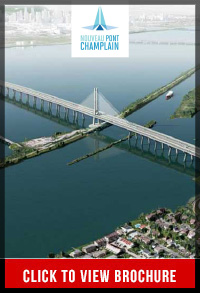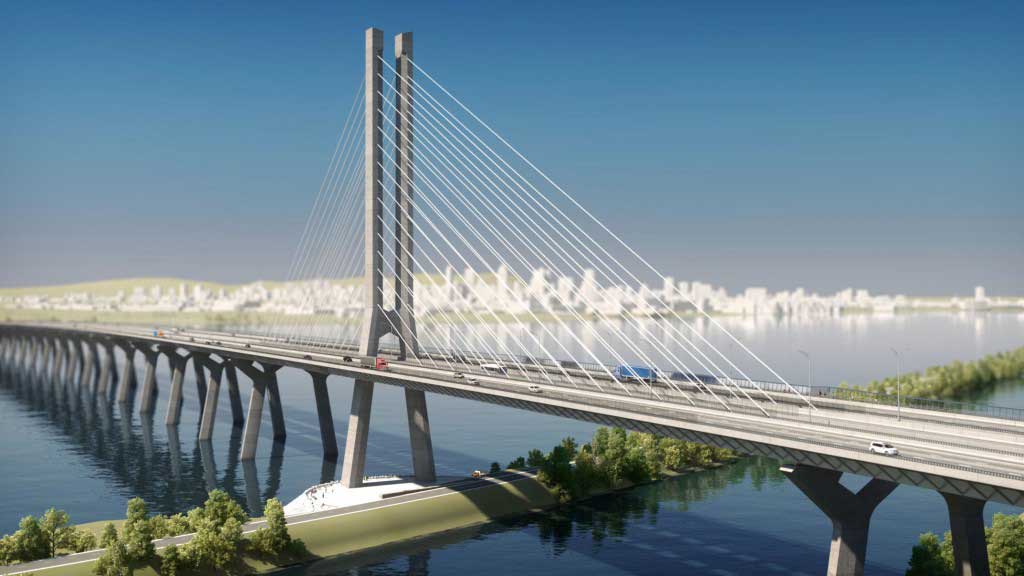Focus on Infrastructure
By Anna Guy
 When writing about the new Champlain Bridge Project, it’s hard to decide where to begin?
When writing about the new Champlain Bridge Project, it’s hard to decide where to begin?
That it’s North America’s largest infrastructure project?
Or the fact that it’s one of the busiest vehicle crossings in Canada—used by up to 60 million vehicles per year?
How about the technical criteria that will achieve a 125-year design life?
While these statements are all true, it has to be the massive Public Private Partnership between the Government of Canada and the Signature on the Saint-Lawrence (SSL) consortium and the immense planning that has gone into the project that makes it most notable.
TIME FOR ACTION
In 2011, murmurs about concerns about the original Champlain Bridge’s condition rose to a roar. Constructed in 1961, the bridge wasn’t built to accommodate the 40 to 60 million vehicles the bridge sees today. Ottawa took a long, cold look at the bridge—and engineering reports—and deemed the bridge’s snapped support cables and disintegrating concrete a safety hazard.
First and foremost, the bridge replacement is vital for public safety. But secondary benefits couldn’t be ignored: the project would be a huge economic boost for the region and stimulate the economy with the creation of thousands of jobs, not to mention the more than $20 billion annually in cross-border goods that pass through that vital trade corridor between Canada and the U.S.
On October 5, 2011, the Government of Canada announced that the Champlain Bridge would be replaced by a new crossing to ensure the safety and security of the public.
Recognizing the aesthetic importance of this new bridge for the Montreal region, the Government of Canada established an architectural review committee to advice on key architectural components which were included in the procurement documents.
The group was composed of representatives from Dissing+Weitling, Provencher Roy, Arup, the City of Montreal, Mission Design, Heritage Montreal, the Ordre des ingénieurs du Québec and the Ordre des architectes du Québec.
In June of 2015, the $3.977 billion new Champlain Bridge Corridor Project Agreement was signed between the Government of Canada and Signature on the St. Lawrence Group (SSL) for the design, construction, financing, operation, maintenance and rehabilitation of the corridor. Construction began that same spring, with the new bridge scheduled to be open in December 2018, and the remainder of the corridor completed in late 2019.
BRIDGE OVERVIEW
It is the distinctive architectural quality of the new bridge that makes it so special. Worthy of its role as the gateway to Montreal, the design elicits appreciation from even the most casual of bystanders.
The new three-kilometre long bridge has been developed alongside rigorously defined technical criteria that will achieve a 125-year design life. The bridge’s curved alignment will create an instant landmark of shore-to-shore design. With the main span tower and its cables adding a unique accent to the bridge. Pedestrians and cyclists on the multi-use path on the bridge, will enjoy showcase views of the city and the Saint Lawrence River.
The construction of the new 3.4-kilometre Champlain Bridge corridor project includes a new 470-metreÎle-des-Sœurs Bridge; the widening of Highway 15 between the Atwater interchange and the new bridge; and the improvement of the ramps leading from Highways 132 and 10 on the South Shore to the bridge.
With Montreal being the economic centre of Quebec and one of the biggest cities in Canada, any project that will strengthen the city by improving the efficiency of a key gateway, such as the new Champlain Bridge corridor project, will contribute to its economic vitality.
The new Champlain Bridge will also contribute to Montreal’s cultural and recreational vitality, providing a significant push to public and active transit. It will of course transform in its own way the urban landscape of Montreal by becoming a new architectural symbol for the metropolis.
COMMUNITY
Doing a project of this magnitude in the middle of one of Canada’s busiest metropolitan areas is not without its challenges. How were they overcome?
Work related to construction of the new Champlain Bridge is happening close to where people live and work, says Dan Genest, Director of coordination for SSL. “This is why Signature on the Saint Lawrence is working closely with the various municipalities bordering the worksite. Together they are identifying the issues, expected work-related impacts and planned mitigation measures.”
SSL is committed to conveying project-related information to citizens throughout the work period and, among other things, hold public information meetings for the neighbouring communities and has established two Good Neighbourly Relations Committees that facilitate dialogue and help create links between citizens and the SSL team.
ENVIRONMENTAL MONITORING
Rigorous environmental monitoring and mitigation measures to protect the surrounding natural environment are being implemented. Large projects, such as the new Champlain Bridge Corridor, have impacts on natural environments, including fish habitat.
That is why the Government of Canada is putting in place projects to compensate for the loss of natural environments with the restoration of the inner marsh on Île Lapierre and the creation of spawning areas in the Vaudreuil Rapids.
The project includes a team of environment professionals responsible for ensuring compliance with the environmental obligations contained in the agreement. They are also collaborating with the new Champlain Bridge design and construction teams to make sure the environmental obligations are taken into account during project design and while establishing construction methods. Numerous permits were obtained from Fisheries and Oceans Canada, Transport Canada, the City of Montreal and the affected boroughs to confirm compliance with these requirements.
Within the project framework, there are many environmental requirements regarding water, surrounding wildlife, air and noise management, and green spaces. An environmental monitoring team is present in the field every day to ensure that the environmental impact mitigation measures established in the construction methods are implemented and provide corrective measures, if necessary, to ensure their effectiveness. This team monitors notably water quality, air quality and noise.
One of their environmental initiatives is related to fish habitat. In order to protect the local fish habitat, SSL is taking certain precautions to minimize the amount of work done in water. For example, when setting up temporary jetties, builders were not permitted to block off more than a third of the width of the river, an obligation that was included in the partnership agreement with the Government of Canada.
Additionally, fish passages were installed at the West Jetty (near L’Île-des-Sœurs) within the St. Lawrence River, allowing for the springtime migration of fish such as the lake sturgeon, a species highly prized by commercial and recreational fishers.
Moreover, a number of other mitigation projects are set up to protect fish habitat. SSL will monitor all these features throughout the construction period and once the project is in operation to make sure they last and remain effective.






